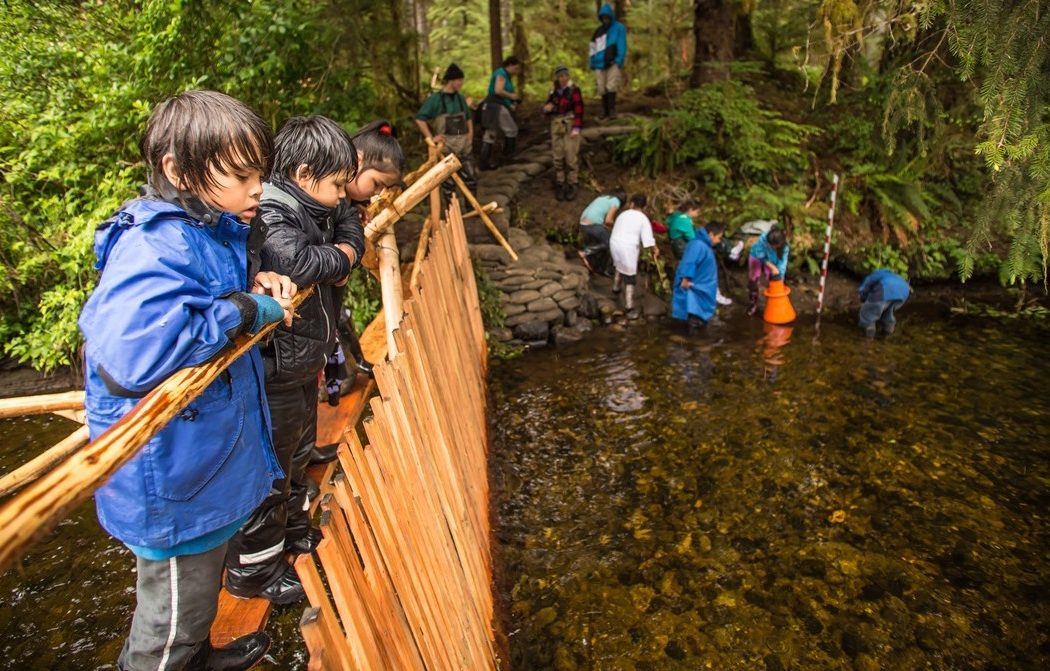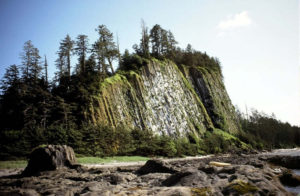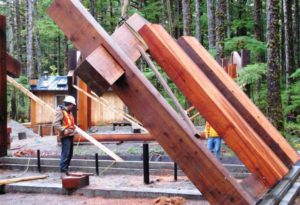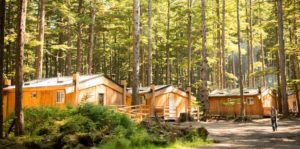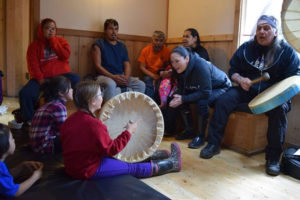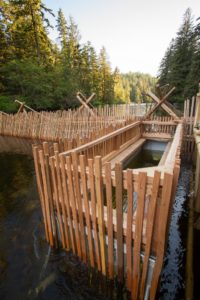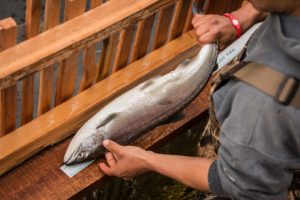Along the spectacular coast of British Columbia, Canada, two First Nations are busy restoring their heritage and revitalizing their economies. On the mainland coast, the Heiltsuk Nation has revived a traditional fishing technology that had disappeared from practice many decades ago (more on that a bit later).
On the northeast tip of Haida Gwaii in the cool coastal forest on Graham Island, the Hiellen River meets pristine North Beach. It’s here that a promising venture in cultural revitalization and economic development has been launched: Hiellen Longhouse Village.
The Old Massett Village Council (OMVC) recently launched a promising new venture designed to regenerate their culture and economy simultaneously. They’ve repurposed and renewed an old industrial site on a long-cherished village site of Tlielang into a hospitality facility that enables them to tap the great demand for ecotourism experiences of visitors to Haida Gwaii.
In the process, they are creating both jobs and workforce training for locals, while also hosting events that contribute to their First Nation’s ongoing cultural revitalization. Visitors enjoy a deeper connection to nature at Hiellen Longhouse Village, and they leave with a stronger appreciation of the culture of the Haida Nation.
Comprising seven individually rentable self-contained cabins and a 10-room building that can be rented by groups, all styled as traditional Haida longhouses, the Village has a distinct feel. Guests don’t come for typical amenities like TV, internet, phones, central heating, linens, or even crystal-clear tapwater; nor do the guests themselves resemble any typical slice of the tourism market.
But they probably leave with a deeper respect for indigenous peoples’ ties to the land—because Hiellen Longhouse Village is as likely to connect them with Haida culture, staff, and families who’ve descended from people who inhabited this site for millennia as it is to host independent young eco-adventurers, seniors, university groups, health retreats and wedding parties.
Tlielang—also known as Hl’yaalan ‘Lngee or Hiellen—was once one of the largest Haida villages. Its residents enjoyed access to the territory’s abundant razor clams, crab, salmon and dogfish—and benefitted from the defensive advantage offered by Taww Tow Hill, a remnant of a volcanic cone on the opposite bank of Hiellen River and the site of an elaborate fort.
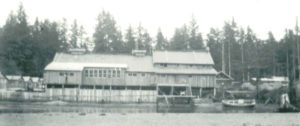 Tlielang was occupied until at least 1860, when Haida–Nisga’a warfare escalated to a point that Tlielang residents chose to abandon it for Old Massett. From 1923 to 1931, the site hosted a cannery that processed razor clams harvested from North Beach.
Tlielang was occupied until at least 1860, when Haida–Nisga’a warfare escalated to a point that Tlielang residents chose to abandon it for Old Massett. From 1923 to 1931, the site hosted a cannery that processed razor clams harvested from North Beach.
A few decades ago, Old Masset Village Council— already co-managing NAIKOON PARK with the Province of B.C. and reasoning that Tlielang’s archeological values had been disturbed by the cannery—turned the site into a campground. Locals have long considered the idea of doing more with the site—including longhouses.
Connecting the Dots
“Hiellen was always on our radar—we just weren’t ready to start it,” says Patricia Moore, a member of the Raven clan from Old Massett and now the Economic Development Planner at Old Masset Village Council. “We were kind of an emerging community in terms of participating in Haida Gwaii’s tourism industry—with just a few gift shops and maybe one B&B.”
But by 2008, Haida Gwaii attractions like North Beach were projected to increase visits to the islands by 15% annually, demand for tourism experiences that connect visitors to indigenous culture and history was skyrocketing, and accommodation options in that part of the Island were scarce. Moore, with an MBA in Aboriginal Business and Leadership and a graduate certificate in project management from Royal Roads, was connecting the dots between these trends and community priorities.
“We also needed a local construction team to build and renovate houses,” she explains, referring to the challenging problems of inadequate local housing for Haida Nation citizens, high unemployment due to a declining fishing industry, and low rates of high school graduation.In 2009, she helped Old Massett Village Council partner with Northwest Community College to develop a program that would help local students get their Red Seal ticket in carpentry.
“A lot of our students had been out of school for a long time,” relates Moore. The program’s initial approach, of trying to impart math skills in the classroom, didn’t work. “Most had had negative experiences in the school system and a fear of math. So we had to find a different approach—one that would build trust and self-esteem.”
Working with a local contractor, program participants started with modest house renovations, like ramps and porches. Then they returned to the classroom to explore the theory of what they’d just done. “[Instructors] would say, ‘Remember how we made that corner? Well, this is the math equation.’ Then everyone passed!” says Moore. “This approach worked for us, and that’s how the whole carpentry program was run.”
Carpentry program participants went on to build a teen centre, and then partnered with a North Vancouver firm to construct an apartment building. Fourteen people were now well on their way to Red Seal status but needed a lot more work to reach the 5,000 required hours.
Tlielang Hiellen’s potential suggested a solution. In 2007, Moore helped Old Masset Village Council flesh out a vision and business plan for Hiellen Longhouse Village: a set of seven 500-square-foot cabins and larger building that could accommodate groups, all styled in the tradition of Haida longhouses.Construction of the Village would not only employ the carpenters in training and use locally milled wood—it would also provide maintenance, caretaking, and potentially food service jobs for HAIDA people (including students in a culinary arts program, another Old Massett Village Council project that Moore helped launch).
It would catalyze the start-up of other local businesses that could offer services to Tlielang Hiellen visitors, like forest tours, story-telling, clam-digging, and bike or ATV rentals. And it would put Tlielang Hiellen on the map as the starting point for an unforgettable multi-day trek through lush rainforest and pristine beaches that could conclude at Haida House, a Haida-owned eco-adventure lodge at Tllaal Tlell, for additional cultural tourism activities.
Realizing the Dream
With a business plan approved by Old Massett Village Council, Moore then set to work writing proposals. In about a year and half she had garnered enough funding to start making the Hiellen Longhouse Village vision a reality. There were a lot of pots of funds to access at the time, remembers Moore. “And I’m good at asking different organizations to believe in us, and invest in us,” she laughs.
Construction on the 10-room, 2,400-square-foot longhouse and first three cabins began in 2012 and was completed before the 2015 operating season, when they were rentable on a by-donation basis while sewage and maintenance issues were worked out. Nestled in the coastal woods of Naikoon Park, adjacent to Tow Hill ecological reserve and steps from expansive beaches, these cabins can be thought of as luxurious indoor camping: simply furnished and extremely well-built, warmed by wood stoves, outfitted with hot showers, limited electric light, and propane stoves for cooking.
By 2016, after only two operating seasons, Hiellen Longhouse Village was already nearing break-even. Management was outsourced to a dynamic local woman who hires local people for caretaking and maintenance positions. Now in its third year, the Village includes seven cabins, the large longhouse, a 1,500-square foot welcome house, a central bathroom and powerhouse.Cabins are 70 to 90 percent booked, usually months in advance and even with minimal advertising. Avid surfers come out in November, and the Christmas season is booked solid. Hiellen Longhouse Village—particularly the large longhouse—also attract a wide range of groups, including weddings and family reunions, schools from on- and off-island, universities offering courses in topics such as indigenous languages and ecology, First Nations youth summer camps, and health centres offering retreats.
New Meaning to “Aboriginal Tourism Experience”
Moore was admittedly surprised by the fact that independent travelers—that is, mostly younger, ecotourism-focused market from off-island—make up a much smaller percentage of Hiellen Longhouse Village customers than initially projected. People from the Island and their families (about half of whom are indigenous) are in fact the mainstay of the business; independent travellers from outside of Haida Gwaii only represent about 30% of individual visitors.
“Hiellen wasn’t built just to make a profit,” notes Moore. “It was about jobs, building tourism infrastructure, and supporting people from Old Massett that want to create their own employment, offering new services.”
And that’s happening. Everyone who stays at Hiellen Longhouse Village gets a list of locally guided activities, such as surfing, clam-digging, birding, and tours of Haida cultural sites. A local woman has set up a surf shop, which has helped extend the business’s shoulder season. Old Massett Village Council’s culinary arts program (which employs four locals) caters events at Hiellen Longhouses, and is now partnering with the Haida dance group, Tluu Xaadaa Naay (Canoe People’s House) to stage fundraising cultural events for Tlielang Hiellen visitors on Friday nights. And the people who built Hiellen Longhouse Village have since developed a cabinet-making business that serves the Haida Gwaii market and beyond.
As regards workers who built the longhouses through the carpentry program, Moore emphasizes that she cannot speak for them—but offers a few thoughts about how it has contributed to the community.
“There is a lot of poverty in Old Massett. It truly affects self-esteem—people start to doubt themselves,” she says. Carpentry program workers were given an hour a day to talk to a counsellor if they wanted, and some of them used that opportunity. Moore recalls that most of the workers were involved in the justice system when the program began, but that declined sharply over the course of the project. “Most of them are working now,” reports Moore, adding that one has started a contracting business.
One worker told Moore that his participation in the program helped him leave alcohol dependence behind—for good. “I think it made a big difference for them to have a job,” reflects Moore. “And they were so excited to build a teen centre, which they didn’t have when they were growing up.”
Ultimately, Hiellen Longhouse Village isn’t just marketing “Aboriginal Tourism Experiences”: it’s creating meaningful experiences for local Haida citizens—as employees, clients, and the broader community of Old Massett.
Restoring An Ancient Fishing Technology
Meanwhile, on the much-smaller Campbell Island to the southeast of Graham Island, an ancient First Nations fishing technology has been restored and put back to use after having disappeared from practice many decades ago.
Working with the Heiltsuk Nation’s Integrated Resource Management Department, scientists from Simon Fraser University’s Department of Biological Sciences, University of British Columbia’s Department of Statistics, and the Hakai Institute, the Qqs Projects Society built a traditional fish weir in the lower Koeye River, and then used it to generate a wealth of useful data about salmon health.
The weir – which is essentially a series of fence panels that span the river and that are supported by sturdy tripods – was designed (and erected in 2013) based on images and archeological evidence of traditional salmon weirs. Installed on June 1st of each year and operating until late July, the weir serves to guide fish, swimming upstream to spawn, into a trap box.
At that point, the fish are briefly anesthetized, tagged for further monitoring, and released to continue their spawning journey. Each week of weir use is associated with a unique tag colour, which allows collection of detailed data about fish movements over the season. Researchers use sophisticated statistical techniques to analyze this data and understand critical relationships between rates of salmon survival and spawning, and factors such as daily river temperatures. This knowledge supports local resource management decisions and enriches our understanding of climate change.
Weirs have used by First Nations in the Pacific Northwest for at least 5,000 years to selectively harvest returning salmon. Technologies such as fish weirs and stone fish traps (learn about the history of KWIAKAH NATION’S FISH TRAPS IN THE PHILLIPS RIVER ESTUARY) helped First Nations evaluate the strength of their salmon returns, and adjust their harvests accordingly, until the late nineteenth century, when they were banned by colonial governments seeking to prohibit First Nations fisheries and bolster commercial fishing. Today, weirs are commonly used by biologists for monitoring fishery health, but are rarely found in the First Nations fisheries where they evolved.
For project collaborators, the KOEYE RIVER weir—which has evolved from a pilot project into a key component of a 10-year salmon-monitoring plan—promises to reverse that trajectory. In addition to developing a mark-recapture method to produce estimates of population abundance to inform local fisheries management, it’s also building long-term capacity in the Heiltsuk community of Bella Bella. In the project’s first four years alone, 10 technicians were employed and trained; many have gone on to other resource management jobs.
More than 200 students have visited the weir through school field trips, and the weir is frequently visited by campers at Qqs Projects Society’s summer camp. Through the project’s association with the Supporting Emerging Aboriginal Stewards (SEAS) program, one or two SEAS interns join the weir crew each year for intensive, hands-on mentorship that’s built into a multi-partner commitment to build stewardship capacity and channel kids into the sciences. All of this disseminates learning about time-honoured Heiltsuk practices around harvesting and stewardship of salmon.
The Qqs Project Society and its collaborators—which include William Housty, chair of the Heiltsuk Integrated Resource Management Department’s board of directors—are sharing their knowledge widely. They’ve just PUBLISHED A PAPER in the academic journal Ecosystem Health and Sustainability, describing the techniques, materials and best practices associated with weir construction and operation.
“We hope that the Koeye River weir can provide a template for other communities seeking to understand and manage salmon populations, and serve as a powerful example of the creative approaches to resource monitoring and stewardship which can arise from collaborations between First Nations communities and academic scientists,” conclude the researchers.
The project is part of a holistic human–bears–salmon approach to monitoring at Qqs’ environmental arm, CoastWatch. Many of the tools being piloted in the weir program support technician training in the Heiltsuk Integrated Resource Management Department, and are being adopted in other watersheds (although Koeye is the only one with an actual weir).
Featured photo is by Grant Callegari / Hakai Institute.

